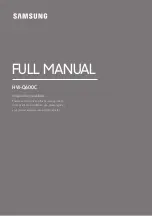
5-6
PAC500
Instruction Manual
4
MAINTENANCE
off (if the power supply is energized). These same normally closed contacts will be closed during actual cutting.
The normally open contacts also operate in reverse of what a casual observer might expect.
When the START button is actuated, CRM is latched through the NC contacts on both the STOP pushbutton and
the voltage sensing relay (3CR), lines 8 and 12. The control relay (CRM) initiates the water (1SOL) and gas (2SOL)
flows, lines 15 and 16, and engerizes the gas preflow timer (1TR), line 18. After 5 seconds the NO contacts of 1TR
close energizing both 2TR and the high frequency circuit, lines 22 and 28. Time delay relay 2TR times in after 1.7
seconds and opens NC contacts ending the high frequency starting cycle, line 28.
Note that water (1SOL) and gas (2SOL) are not automatically shut off at the end of the cycle in the TEST mode
because the NC contacts of the voltage sensing relay (3CR) remain closed. The STOP button must be actuated to
terminate gas and water flow.
Two Torch Operation
Two torch Operator's Panel is described in Figure 10. This circuit interfaces with two separate consoles.
Independent control of each console is provided by a separate ON/OFF switch (1SS and 3SS). The mode of
operation is controlled by a single TEST/RUN relay (1CR). For example, to operate both consoles on TEST, 2SS is
placed in the TEST mode and both 1SS and 3SS are placed in the ON position. The TEST mode can be restricted
to console #2 by switching 1SS to OFF.
The control relay (5CR) mounted in the Operator's Panel is energized on 1TR, line 22, figure 9. When both
consoles are ON, the first preflow delay relay (1TR) to time in will energize 5CR, which actuates both high
frequency starting circuits simultaneously. Three and four torch systems are a simple iteration of this circuit.
Run Mode
After the proper gas and water flows have been set, the TEST/RUN switch is placed in the RUN Mode. The NO
contacts, line 5, of the TEST/RUN switch close, energizing 1CR. This closes the 1CR NO contacts in the power
supply contactor control circuit, line 13, and in the machine start circuit, line 26. When the START button is
actuated, CRM is latched and CON is energized through 1CR, 1FLS, 2FLS flowswitch and 1PS pressure switch.
A water flow of at least .25 gpm to the nozzle is required to close 2FLS; 1FLS requires a minimum of 1.5 gpm.
Gas flow must be sufficient to create a backpressure greater than 30 psi to close 1PS.
The voltage sensing relay 3CR is energized by the open circuit voltage of the power supply (400 volts) which in
turn energizes the pilot arc relay (4CR), line 19, thereby providing continuity between the nozzle and ground
through the 3 ohm water cooled resistor, R2, line 32. Control relay CRM is held in by NC contacts on 2TR during
the start cycle. Time delay relay 1TR closes NO contacts, line 22, after 5 seconds to energize 2TR, line 22, and the
high frequency starting circuit, line 28. The high frequency initiates the pilot arc between the electrode and nozzle,
line 33. the pilot arc current is limited by the water cooled pilot arc resistor (R2), line 32. The pilot arc immediately
transfers to the workpiece, dropping the voltage to a value between 125 volts and 220 volts, thereby de-energizing
3CR. This closes 3CR NC contacts, line 12, holding in CRM and energizes the machine start relay (2CR), line 26.
The high frequency starting cycle is ended by 3CR contacts, line 28, returning to the NO state. The pilot arc relay
(4CR) is also de-energized by 3CR returning to the NO state, line 19.
At the conclusion of the cut, the STOP pushbutton is actuated which opens CRM and drops out the control circuit.
If the torch is run off the workpiece, the main arc will go out and the voltage sensing relay will be energized by the
open circuit voltage dropping out both CRM, line 11, and the machine start relay (2CR), line 26. If no main arc is
established, 3CR will remain energized and CRM will drop out after 2TR times in, line 11, automatically ending the
cycle.
Summary of Contents for PAC500
Page 1: ...Water Injection Plasma Cutting System Instruction Manual 800370 Revision 4 PAC500 ...
Page 53: ...5 12 PAC500 Instruction Manual 4 MAINTENANCE Figure 1 PAC500 Schematic Layout ...
Page 56: ...PAC500 Instruction Manual 5 15 4 MAINTENANCE Figure 4 Direction of Cut Figure 5 Cut Angle ...
Page 60: ...PAC500 Instruction Manual 5 19 4 MAINTENANCE Figure 9 Plasma Console Electrical Schematic ...
Page 63: ...6 2 PAC500 Instruction Manual 4 PARTS LIST Model 500 Torch 1 2 3 4 3 6 7 5 3 ...
Page 65: ...6 4 PAC500 Instruction Manual 4 PARTS LIST Torch Leads ...
Page 69: ...6 8 PAC500 Instruction Manual 4 PARTS LIST Remote Stop Start 6 3 2 1 4 5 ...
Page 71: ...6 10 PAC500 Instruction Manual 4 PARTS LIST Argon Hydrogen Manifold 14 ...
Page 73: ...6 12 PAC500 Instruction Manual 4 PARTS LIST 1 Torch Operator s Panel ...
Page 75: ...6 14 PAC500 Instruction Manual 4 PARTS LIST 2 Torch Operator s Panel ...
Page 81: ...6 20 PAC500 Instruction Manual 4 PARTS LIST Plumbing Compartment PAC500 Console ...
Page 82: ...PAC500 Instruction Manual 6 21 4 PARTS LIST Plumbing Compartment with Kobold Flow Switches ...
Page 88: ...a 2 PAC500 Instruction Manual 4 ...
Page 89: ...PAC500 Instruction Manual a 3 4 ...
Page 90: ...a 4 PAC500 Instruction Manual 4 ...
Page 91: ...PAC500 Instruction Manual a 5 4 ...
Page 93: ...PAC500 Instruction Manual a 7 4 ...
Page 94: ...a 8 PAC500 Instruction Manual 4 ...
















































